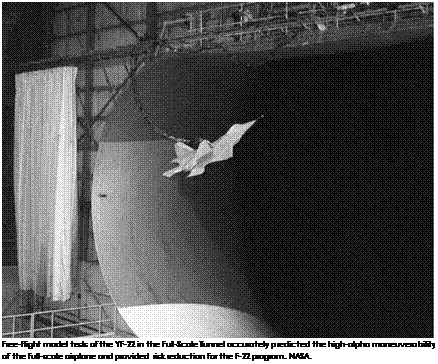Fifth Generation: The F-22 Program
The Air Force initiated its Advanced Tactical Fighter (ATF) program in 1985 as an effort to augment and ultimately replace the F-15. During the competitive phase of the program between the Northrop-led YF-23 and the Lockheed-led YF-22 designs, the Air Force established that each team could draw on the facilities and expertise of NASA for establishing credibility and risk reduction before a competitive fly-off. Lockheed subsequently requested free-flight and spin tests of the YF-22 in the Langley Full-Scale Tunnel and the Langley Spin Tunnel. The relatively
compressed timeframe of the ATF competition would not permit a feasible schedule for the fabrication and testing of a helicopter drop model of the YF-22.
![]() A joint NASA-Lockheed team conducted conventional tunnel tests in the Full-Scale Tunnel in 1989 to measure YF-22 aerodynamic data for high-angle-of-attack conditions, followed by free-flight model studies to determine the low-speed departure resistance of the configuration. Meanwhile, spin tunnel tests obtained information on spin and recovery characteristics as well as the size and location of an emergency spin recovery parachute for the high-angle-of-attack test airplane. In addition, specialized "rotary-balance” tests were conducted in the spin tunnel to obtain aerodynamic data during simulated spin motions. Lockheed incorporated all of the foregoing results in the design process, leading to an impressive display of capabilities by the YF-22 during the competitive flight demonstrations in 1990.
A joint NASA-Lockheed team conducted conventional tunnel tests in the Full-Scale Tunnel in 1989 to measure YF-22 aerodynamic data for high-angle-of-attack conditions, followed by free-flight model studies to determine the low-speed departure resistance of the configuration. Meanwhile, spin tunnel tests obtained information on spin and recovery characteristics as well as the size and location of an emergency spin recovery parachute for the high-angle-of-attack test airplane. In addition, specialized "rotary-balance” tests were conducted in the spin tunnel to obtain aerodynamic data during simulated spin motions. Lockheed incorporated all of the foregoing results in the design process, leading to an impressive display of capabilities by the YF-22 during the competitive flight demonstrations in 1990.
Lockheed formally acknowledged its appreciation of NASA’s participation in the YF-22 program in a letter to NASA, which stated:
On behalf of the Lockheed YF-22 Team, I would like to express our appreciation of the contribution that the people of NASA Langley made to our successful YF-22 flight test program, and provide some feedback on how well the flight test measurements agreed with the predictions from your wind-tunnel measurements. . . . The highlight of the flight test program was the high-angle-of-attack flying qualities. We relied on aerodynamic data obtained in the full-scale wind tunnel to define the low – speed, high-angle-of-attack static and dynamic aerodynamic derivatives; rotary derivatives from your spin tunnel; and free- flight demonstrations in the full-scale tunnel. We expanded the flight envelope from 20° to 60° angle of attack, demonstrating pitch attitude changes and full-stick rolls about the velocity vector in seven calendar days. The reason for this rapid envelope expansion was the quality of the aerodynamic data used in the control law design and pre-flight simulations.[1322]
 |
|
After the team of Lockheed, Boeing, and General Dynamics was announced as the winner of the ATF competition in April 1991, high – angle-of-attack testing of the final F-22 configuration was conducted in the Full-Scale Tunnel and the Spin Tunnel. Aerodynamic force testing was completed in the Full-Scale Tunnel in 1992, with spin – and rotary – balance tests conducted in 1993. A wind tunnel free-flight model was not fabricated for the F-22 program, but a typical full-scale tunnel model was constructed and used for the aerodynamic tests. A notable contribution from the spin tunnel tests was a relocation of the attachment point for the F-22 emergency spin recovery parachute to clear the exhaust plume of the vectoring engine in 1994. Langley’s contributions to the high – angle-of-attack technologies embodied in the F-22 fighter had been completed well in advance of the aircraft’s first flight in September 1997.[1323]










